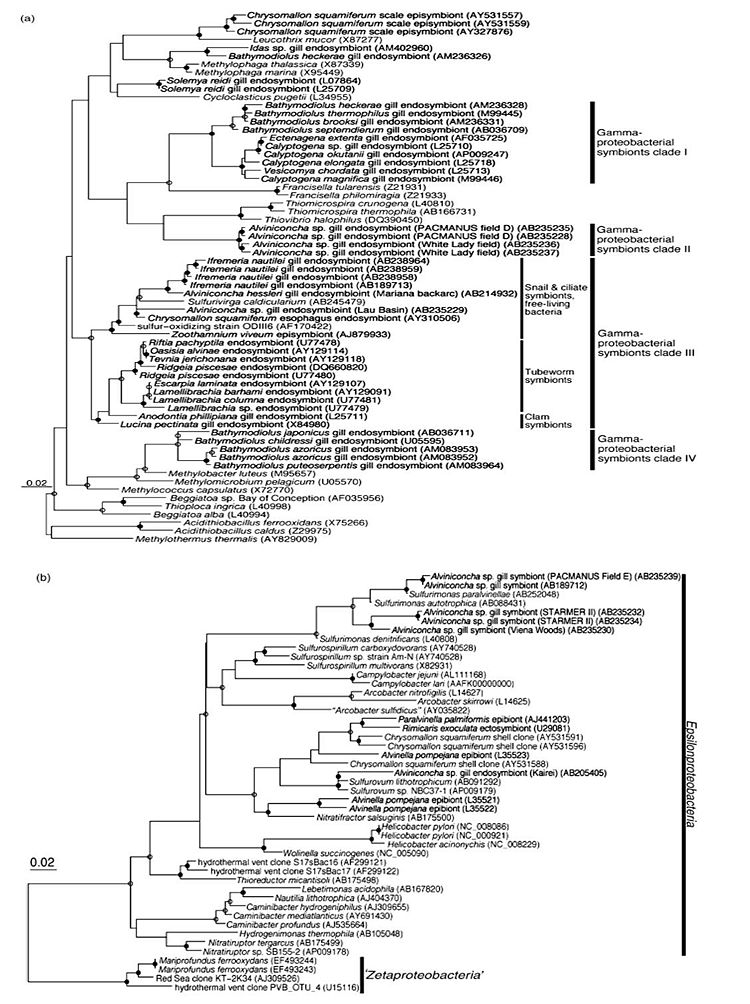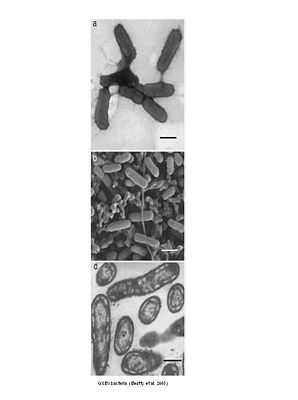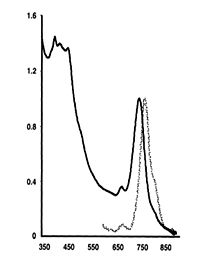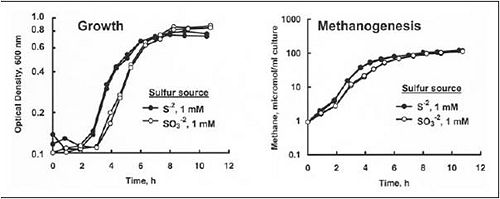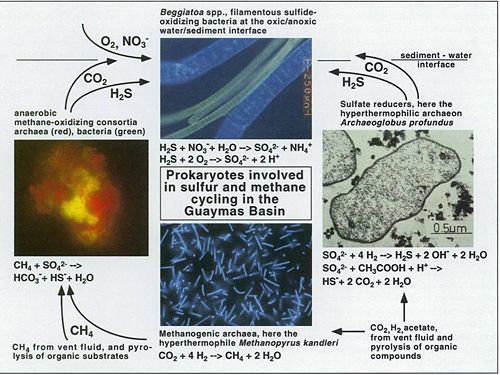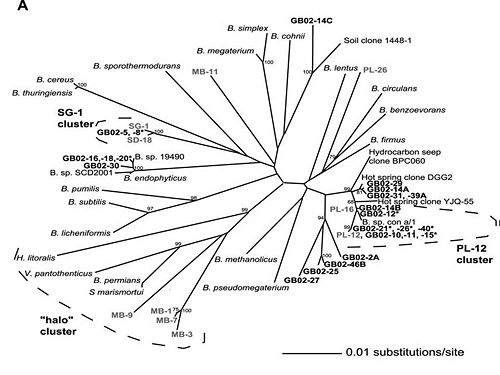Chemotrophy Along Seafloor Hydrothermal Vents
by Pamela Moriarty
Introduction- Microbial Life Along the Hydrothermal Vents

Earth’s oceans are populated by microorganisms which perform a wide range of important services. Three oceans, the Atlantic, Pacific and Indian, contain hydrothermal vents (figure 1) along their floor. Hydrothermal vents are formed where ocean plates pull apart and hot, mineral rich water and lava escape. Living along or in hydrothermal vents can pose great challenges to microorganisms. Most deep-sea hydrothermal vents contain low amounts of manganese, sulfate, and elemental sulfur, while being abundant in silica, metals and dissolved gases. Seawater circulation allows for ion exchange and helps carry certain molecules, such as ammonia, iron, manganese, hydrogen sulfide, molecular hydrogen, carbon monoxide, and methane, to the deep sea. However, this leads to more challenges for microorganisms inhabiting the vents, as the high concentrations of iron, and ammonia can affect metabolism (Karl 1995). The high pressure along the entire sea floor also presents challenges. Finally, temperature is extremely variable, supporting both psychrophiles living below 10⁰C and superthermophiles living above 115⁰C (Van Dover 2000). The wide range of environments occurring by the hydrothermal vents on the ocean floor present a set of unique challenges to microorganisms. We are just beginning to understand the variety of adaptations they have evolved to meet these challenges.
While some environmental conditions remain the same from vent to vent, there are also major differences between vents in potential carbon and energy sources available. In addition, there are nutrient gradients within vent ecosystems due to circulation patterns. Each vent typically contains four distinct microbial habitats: 1) emitted vent fluid that contain free-living microbial populations, 2) rock, chimney, sediment and animal surfaces exposed to vent fluids that contain free-living microbial populations, 3) vent fauna and microorganisms in endo and exosymbiotic relationships and 4) the hydrothermal vent plumes. (Karl 1995).
The metabolic processes used by microorganisms in these environments span a wide range of electron donors and acceptors. Many, if not most, microbes along the hydrothermal vents practice mixotrophy, using combinations of different metabolic pathways based on what is available in the highest concentrations. Potential aerobic chemosynthetic processes include oxidation of sulfur compounds including sulfide, thiosulfate, hydrogen sulfide and elemental sulfur, as well as iron, manganese, carbon-compound and hydrogen oxidation and nitrification, while anaerobic chemosynthetic possibilities include sulfur or sulfate reduction, denitrification and methanogenesis. The diversity and phylogeny of just mesophilic chemoautotrophs is shown in figure 2 (Satoshi et al. 2009) and includes sulfur-oxidizers and reducers as well as methylotrophs. As the vents support microbes ranging from psychrophiles to superthermophiles, this is just a small proportion of the microbes that are important in these ecosystems. In the environment, aerobic chemosynthesis uses oxygen as the electron acceptor, which has relatively large energy yields, allowing for the production of large amounts of biomass. Under anaerobic conditions, molecular hydrogen is typically the electron donor. Hydrogen oxidation also yields high amounts of energy, but along the hydrothermal vents the low amounts of hydrogen available mean that little biomass can be produced through anaerobic chemosynthesis. Most likely, sulfide oxidation accounts for most of the energy available in this environment. (Van Dover 2000)
In addition to chemotrophy, two alternative hypotheses of energy production have been proposed. The first is organic thermogenesis, in which organic simple molecules such as thiocyanate and glycine are generated abiotically when sea water and hot rock react at large depths. Some sulfur compounds can also be synthesized from formaldehyde and sulfur that are in hydrothermal vent fluids. Other organic thermogenesis pathways include the possibility of producing urea, alkanes and alkenes abiotically. Another proposed hypothesis is detrital thermal alteration, the degradation of compounds by the hot fluids expelled at the hydrothermal vents. The hot fluid passing over the compounds can lead to changes in their composition. Along the hydrothermal vents, refractory carbon, heat resistant carbon produced by microbes, is able to be further degraded by the heat from the vent fluids to petroleum hydrocarbons and volatile fatty acids, which can then be used by heterotrophic microbes. While these hypotheses have not been extensively studied, they are interesting alternatives for energy production. (Van Dover 2000)
Microorganisms inhabiting hydrothermal vents have many possible biotechnological applications. One possibility is using microbes for bioremediation of waste sulfides and returning the resulting sulfate to the oceans and using the bacterial biomass as food for aquaculture or fermenting it into synfuels. Hyperthermophilic bacteria may also provide enzymes useful in a variety of molecular techniques including PCR, amylases, glucosidases and proteases as they are stable at a wide range of temperatures and may also be resistant to detergents and organic solvents. (Van Dover 2000).
It was long thought that there was no life along deep-sea hydrothermal vents because organisms would not be able to produce enough energy to live. Obviously this is now known to be incorrect, as microbes there have been found to be diverse and abundant, and larger organisms, including mussels, snails, sponges and shrimp have been found, though there are likely thousands more microorganisms that are unculturable that we have not yet discovered or been able to identify. Oxidation and reduction of sulfur are thought to be the prevalent metabolic pathways for life along the hydrothermal vents. Methylotrophy and methanogenesis also play extremely important roles, while iron, manganese, hydrogen and ammonia oxidation are just beginning to be studied in depth.
Oxidation and Reduction of Sulfur Compounds
Some of the most common pathways of energy production in microorganisms who live along the hydrothermal vents are oxidation or reduction of sulfur compounds. The most common electron donor along the vents is hydrogen sulfide, making oxidation of sulfur containing compounds the base of the food web in this environment (Van Dover 2000, Jannasch 1995). The microorganisms in this environment capable of oxidizing or reducing sulfur compounds show amazing diversity. Over 161 gram-negative sulfur-oxidizing bacteria species have been found to inhabit the hydrothermal vents. Bacteria in this environment are often thought of as all being autotrophs, but of these 161 species, over 97% are also capable of heterotrophic growth. In addition, 37% perform fermentation and 88% perform denitrification (Van Dover 2000). Furthermore, the sulfate reducers known to be present include at least nine different genera, including gram-negative and positive species. While most are rod shaped or vibrios, others are ovoid or filamentous. Some of the microorganisms have been found to only perform partial oxidation of a limited range of carbon sources, while others can perform oxidation with short and long chain fatty acids and organic compounds (Hamilton 1987). The diversity that has already been discovered is astonishing.
S-oxidizing bacteria (those that oxidize sulfur, sulfate, thiosulfate or other sulfur compounds) include chemolithoautotrophs, chemolithoheterotrophs, chemolithomixotrophs and chemoorganoheterotrophs. Most use oxygen as a terminal electron acceptor, though some are capable of using nitrate. Thiosphaera panotropha is even capable of using oxygen and nitrate simultaneously (Karl 1995).
S-reducing bacteria can use sulfate, thiosulfate, or elemental sulfur as their terminal electron acceptor. The byproduct is typically sulfide. S-reduction produces a much lower amount of energy than reducing oxygen or nitrogen. If one mole of lactate is oxidized with oxygen as the electron acceptor 298 kcal is released, while if sulfate is the electron acceptor, just 9.7 kcal is released. However, the abundance of sulfate along the hydrothermal vents makes this a profitable metabolic pathway for many microorganisms.
Many microbes, in many different environments, practice mixotrophy. Along the hydrothermal vents microbes commonly perform oxidation or reduction of S-compounds along with other methods to produce more energy. An interesting combination, found by Beatty et al., is performed by a photosynthetic anaerobe that also oxidizes sulfur compounds. The bacteria GSB1 was found in a hydrothermal vent plume in the East Pacific Rise. While geothermal light was known to exist, it was not previously thought to be enough for photosynthesis to occur. However, the discovery of this microbe changes that view. GSB1 is believed to be a green sulfur bacteria (Figure 3). It is rod shaped, gram-negative and contains chlorosomes. When isolated in pure culture it absorbed similar wavelengths to Chlorobium and Prosthecochloris.
The peak absorbance occurred at about 750 nm and peak fluorescence occurred at about 775 nm (Figure 4), implying that GSB1 contains bacteriochlorophyll c. GSB1 also absorbed efficiently around 450 nm, indicating the presence of carotenoids. Using mass spectroscopy, the carotenoids were identified to most likely be chlorobactene. The 16S rRNA sequence of GSB1 is similar to that of Chlorobium and Prosthecochloris, however it also has a unique Fenna-Matthews-Olson (FMO) protein to harvest light. The FMO proteins most similar to it are again found in Chlorobium and Prosthecochloris. Due to these similarities, GSB1 was determined to be related to the Chlorobium and Prosthecochloris genera. GSB1 is obligately photosynthetic, requiring light in addition to hydrogen sulfide or elemental sulfur and carbon dioxide to grow. The discovery of an obligate photosynthetic green sulfur bacteria along the hydrothermal vents of the ocean floor is fascinating, and opens the door to the possibility of life in other environments that have been thought to be inhabitable. (Beatty et al. 2005)
In addition to mixotrophy, S-oxidizing bacteria are commonly found in symbiotic relationships along the hydrothermal vents. They have been found in at least 5 families of bivalves (Karl 1995), tube worms, and snails. Two meter long tubeworms that contain no mouth or gut have been found. These are able to exist only due to chemoautotrophic endosymbionts. The tubeworms trophosomes were found to be packed with prokaryotic cells that produce organic material from inorganic compounds obtained from the tubeworm. The bacteria then transfer organic material back to the host to allow it to survive. Bathymodiolus mussels, vesicomyid clams and pectinid scallops also have chemoautotrophic bacteria that live in their gills. The gastropod Ifremeria nautilei has 15-20 times the number of gill filaments and a stomach 1/10 of the size of members of its family that do not contain endosymbionts. (Van Dover 2000)
At the Lau Basin hydrothermal vents in the Pacific Ocean, the distribution of two species of snails, Alviniconcha sp. 1 and Infremeria nautilei and a mussel, Bathymodiolus brevior, was found to be in concentric circles around a diffuse hydrothermal source at least partially due to the pattern of reduced sulfur compounds. The Alvinconcha were present in the water with the highest concentration of sulfide. Moving out to the I. nautilei, the concentration of polysulfides increased as the concentration of free sulfide dropped, and among the B. brevior thiosulfates were prevalent, with free sulfide concentrations sometimes undetectable. All 3 organisms depend on endosymbionts to produce energy and the variation in the species of symbionts they contain results in different preferences for types of sulfur compounds. The pattern of concentric circles allows each microbe species maximum exposure to their preferred sulfur source, thereby allowing the larger organism to obtain maximum energy. (Waite et al. 2008)
Methylotrophy and Methanogenesis
In addition to S-oxidizers and reducers, there are several types of bacteria and archaea found along deep-sea hydrothermal vents that either oxidize or produce carbon containing compounds. Methylotrophs oxidize single-carbon compounds , while methanogens use metabolic pathways that produce methane. Methanogens can use a variety of substrates including carbon dioxide, methanol, formic acid, acetic acid and methylamines. Under certain conditions, some can use elemental iron as an electron donor to reduce carbon dioxide to methane. Others can reduce elemental sulfur to hydrogen sulfide in addition to performing methanogenesis. This may help account for the hydrogen sulfide that is often present near them and may help maintain an anaerobic environment, which is necessary for them to perform methanogenesis. (Karl 1995).
Methylotrophs differ from methanogens by using carbon substrates as electron donors to produce energy. Possible substrates include carbon monoxide, methane, methanol, formic acid, foramide, cyanide, and methylamines. Bacteria that oxidize methane are also referred to as methanotrophs (Jannasch 1995). Some methanotrophs are also capable of oxidizing ammonium, as both processes start with a monooxygenase reaction (Karl 1995). Anaerobic methanotrophs have been found to exist in the Guaymas Basin along the hydrothermal vents. At least two archaea- ANME-1 and ANME-2 have been identified by their 16S rRNA gene sequence (Teske et al. 2003). Methanotrophy is typically thought of as a heterotrophic process as most methanotrophs use organic methane. However, it is also possible for methane to be produced abiotically, making it inorganic. In this way, methanotrophy can be either auto or heterotrophic depending on the production pathway of the methane used.
While many organisms are involved in symbiotic relationships with S-oxidizing bacteria, methylotrophs or methanogens, there are at least 2 mussel species that have a dual symbiosis, fostering both thiotrophs and methanotrophs simultaneously. The bi-valve mussel species Bathymodiolus azoricus and Bathymodiolus puteoserpentis are prevalent along the Mid-Atlantic Ridge. By using transmission electron microscopy, enzymatic assays and 16S rRNA sequence analysis, these mussels have been shown to contain both chemoautotrophic sulfide-oxidizing bacteria and methanotrophic bacteria. Duperron et al. (2006) sampled four vent sites and all individuals collected contained two dominant bacterial phylotype groups. The dominant thiotrophs collected at different sites shared very similar 16S rRNA sequences, as did the dominant methanotrophs, indicating that the same symbionts were present at the different sampling sites along the vent. The distribution and relative abundance of symbionts in the mussels was similar in individuals from the same site, but differed among sites. The relative concentrations of sulfide and methane at a site may determine the relative proportions of types of symbionts. At the Rainbow site, methane concentrations were elevated, and mussels contained higher proportions of methanotrophs. Sulfide concentrations were highest at the Lucky Strike and Snake Pit sites and the mussels there harbored a higher proportion of thiotrophs.
Methanogens are able to live successfully along hydrothermal vents despite the fact that methanogenesis is inhibited by sulfite, which is commonly found in this environment. Sulfide reacts with oxygen in the vent fluid, establishing anaerobic conditions which favor methanogens, but also producing sulfite, which is toxic to them, as it inactivates coenzyme M reductase, which is essential for performing methanogenesis.
There have been three microorganisms from the hydrothermal vents, Methanothermobacter thermautotrophicus, Methanothermococcus thermolithotrophicus and Methanocaldococcus jannaschii that have been reported to not only grow with sulfite (Figure 5), but use it as a sulfur source. Methanocaldococcus jannaschii was found to be incapable of growth without the presence of sulfite. Coenzyme F420-dependent sulfite reductase (Fsr) was found in M. jannaschii. Fsr is oxygen sensitive and its expression is induced by sulfite. Fsr reduces sulfite into sulfide using H2F420 as an electron donor, allowing M. jannaschii to grow in the presence of sulfite and use it as a sulfur source. This adaptation allows M. jannaschii to thrive in environments previously thought inhabitable by methanogens. Other methanogens may harbor similar enzymes, though they have not yet been identified. (Johnson et al. 2005)
Methylotrophy and methanotrophy are not thought to be as dominant as S-oxidation and reduction, but still represent important processes and are closely linked to oxidation and reduction of S-compounds (Figure 6) (Teske et al. 2003).
Less Common Pathways- Iron, Manganese, Hydrogen and Ammonia Oxidation
Finally, there are several other metabolic pathways that have been found to occur along the hydrothermal vents, including iron, manganese, hydrogen, and ammonia oxidation. They have not yet been studied extensively and their role in energy production along the hydrothermal vents is not well understood.
Hydrothermal vent fluids typically contain elevated levels of reduced metals such as ferrous iron, manganese and copper, though ferrous iron is often present in the highest concentration (Satoshi et al. 2008). However, oxidation of ferrous iron has often been considered energetically unfavorable and therefore not thought to occur along the hydrothermal vents (Schmidt et al. 2008). The shrimp Rimicaris exoculata is abundant at vents along the Mid-Atlantic Ridge, including the Rainbow and TAG sites and depends on microbe symbionts for energy production. Until recently, it was thought that the only electron donor these microorganisms use is sulfide. Hydrothermal fluid at the Rainbow site contains high levels of hydrogen, ethane and ferrous iron, while being depleted in sulfide. Due to the high concentration of iron, total potential energy at the Rainbow site from ferrous iron was calculated to be higher than that of sulfide, methane, or hydrogen sulfide. Swarms of the shrimp gather in areas with very specific temperature ranges, where ferrous iron concentrations are elevated. If forced to leave this area, they return as soon as possible. The areas where the R. exoculata gather appear to be optimal for growth relying on ferrous iron oxidation, and it is likely that they depend on microbes capable of ferrous oxidation for growth. (Schmidt et al. 2008)
Manganese oxidation has been found to be performed by a large variety of spore-forming Bacillus species. A large number of heterotrophic, mesophilic, manganese-oxidizing alpha and gamma proteobacteria were isolated from the Guaymas Basin hydrothermal vent. They were incubated at 80⁰C for 20 minutes to kill the non-spore forming species. The remaining colonies were identified using cultures and 16S rRNA sequences. There were over twenty strains identified from these samples. Many were found to be part of already defined clusters, but others were found to be distinct lineages and two new clusters were identified (Figure 7). One Bacillus strain identified, GB02-14 is very different than any of the other known manganese-oxidizers and appears to be most closely related to a soil bacterium. Four of the strains isolated form a distinct cluster with three previously known strains, B. endophyticus, B. sp. Strain 19490 and B. sp. Strain SCD-2001, that are not known to oxidize manganese. Three of the four strains identified as part of this cluster had identical 16S rRNA sequences. All of the manganese- oxidizing strains isolated from the Guaymas Basin hydrothermal vent contained a multicopper oxidase gene, mnxG, which indicates that they probably have the same copper dependent manganese-oxidation mechanism as previously characterized Bacillus spores that perform manganese- oxidation. Previous bacteria that also perform manganese-oxidation had been collected in previous expeditions to hydrothermal vents at the Juan de Fuca Ridge. The genes from these were sequenced to try to determine if they were related. Two spore-forming Bacillus strains were identified, both of which fell into already identified clusters. The presence of Bacillus spores capable of manganese- oxidation at two different vent locations makes their existence likely at hydrothermal vents throughout the oceans. (Dick et al. 2006)
Hydrogen oxidation can also be an important energy source from some hydrothermal vent fluids, though molecular hydrogen is typically less abundant at these sites than hydrogen sulfide. Chemoautotrophs that have been isolated from the hydrothermal vents capable of hydrogen oxidation include Aquificales, Epsilonproteobacteria, Desulfurococcales, Methanococcales, Thermodesulfobacteriales and Deferribacterales. Several strains of Epsilonproteobacteria have multiple sets of hydrogenases, enzymes necessary for catalyzing the oxidation of molecular hydrogen. The fact that strains have multiple sets of these enzymes indicates the importance of hydrogen oxidation for these strains of microorganisms. (Satoshi et al. 2008)
Ammonia is produced in high quantities along hydrothermal vents by thermal degradation of organic compounds. Along the Juan de Fuca Ridge it was shown that chemoautotrophs consumed ammonium rapidly after it was expelled from the vents, though none of these chemoautotrophs have been successfully isolated yet. (Satoshi et al. 2008)
While little is known about the role of iron, manganese, hydrogen and ammonia oxidation near deep-sea hydrothermal vents, these processes have all been documented and are potentially important parts of the food web.
Conclusion
Chemotrophic microorganisms play an important role in seafloor hydrothermal vents, forming the base of the food web. They have evolved to use multiple metabolic pathways in response to different concentrations of potential energy sources at different sites and are commonly involved in symbiotic relationships with larger organisms that have become completely dependent on the microbes they foster due to reductive evolution. As they live in an extremely hostile environment, the array of features and processes that microorganisms in this environment show is truly amazing.
References
Beatty, Thomas J., Jorg Overmann, Michael T. Lince, Ann K. Manske, Andrew S. Lang, Robert E. Blankenship, Cindy L. Van Dover, Tracey A. Martinson, F. Gerald Plumley, and Bob B. Buchanan. “An Obligately Photosynthetic Bacterial Anaerobe from a Deep-Sea Hydrothermal Vent.” Proceedings of the National Academy of Sciences of the United States of America. 2005. Volume 102. p. 9306-9310.
Dick, Gregory J., Yifan E. Lee and Bradley M. Tebo. “Manganese (II)-Oxidizing Bacillus Spores in Guaymas Basin Hydrothermal Sediments and Plume.” Applied and Environmental Microbiology. 2006. Volume 72. p. 3184-3190.
Duperron, Sébastien, Claudi Bergnin, Frank Zielinski, Anna Blazejak, Annelie Pernthaler, Zoe P. McKiness, Eric DeChaine, Colleen M. Cavanaugh and Nicole Dubilier. “A dual symbiosis shared by two mussel species, Bathymodiolus azoricus and Bathymodiolus puteoserpentis (Bivalvia: Mytilidae), from hydrothermal vents along the northern Mid-Atlantic Ridge.” Environmental Microbiology. 2006. Volume 8. p. 1441-1447.
Hamilton, W. Allan. “Sulphate-reducing Bacteria and the mechanism of corrosion in the marine environment.” 1987. In: Microbes in the Sea, ed. Michael A. Sleigh. Ellis Horwood Limited, England, p. 190-202.
Karl, David M. “Ecology of Free-Living, Hydrothermal Vent Microbial Communities.” 1995. In: The Microbiology of Deep-Sea Hydrothermal Vents, ed. David M. Karl. CRC Press, Boca Raton, p. 35-124.
Jannasch, Holger W. “Microbial Interactions With Hydrothermal Fluids.” 1995. In: Seafloor Hydrothermal Systems- Physical, Chemical, Biological and Geological Interactions, ed. Susan E. Humphris, Robert A. Zierenberg, Lauren S. Mullieneaux and Richard E. Thomson. American Geophysical Union, United States, p. 273-296.
Johnson, Eric F. and Biswarup Mukhopadhyay. “A New Type of Sulfite Reducatase, a Novel Coenzyme F420-dependent Enzyme, from the Methanarchaeon Methanocaldococcus jannaschii.” The Journal of Biological Chemistry. 2005. Volume 280. p. 38776-38786.
Satoshi, Nakagawa and Ken Takai. “Deep-sea vent chemoautotrophs: diversity, biochemistry and ecological significance.” FEMS Microbiology Ecology. 2009. Volume 65. p. 1-14.
Sherr, Evelyn and Barry Sherr. “Marine Microbes: An Overview.” 2000. In: Microbial Ecology of the Oceans, ed. David L. Kirchman. Wiley-Liss, Inc, New York, p. 13-46.
Schmidt, Caroline, Renaud Vuillemin, Christian Le Gall, Françoise Gaill and Nadine Le Bris. “Geochemical energy sources for microbial primary production in the environment of hydrothermal vent shrimps.” Marine Chemistry. 2008. Volume 108. p. 18-31.
Teske, Andreas, Ashita Dhillon, and Mitchell L. Sogin. “Genomic Markers of Ancient Anaerobic Microbial Pathways: Sulfate Reduction, Methanogenesis and Methane Oxidation.” Biological Bulletin. 2003. Volume 204. p. 186-191.
Van Dover, Cindy Lee. The Ecology of Deep-Sea Hydrothermal Vents. 2000. Princeton University Press, Princeton, 424 p.
Waite, Tim J., Tommy S. Moore, James J. Childress, Helen Hsu-Kim, Katherine M. Mullaugh, Donald B. Nuzzio, Amber N. Paschal, Jeffrey Tsang, Charles R. Fisher, and George W. Luther III. “Variation in Sulfur Speciation with Shellfish Presence At a Lau Basin Diffuse Flow Vent Site.” Journal of Shellfish Research. 2008. Volume 27. p. 163-168.
Edited by student of Joan Slonczewski for BIOL 238 Microbiology, 2009, Kenyon College.
Retrieved from "http://microbewiki.kenyon.edu/index.php/BIOL_238_Paper_2009"
